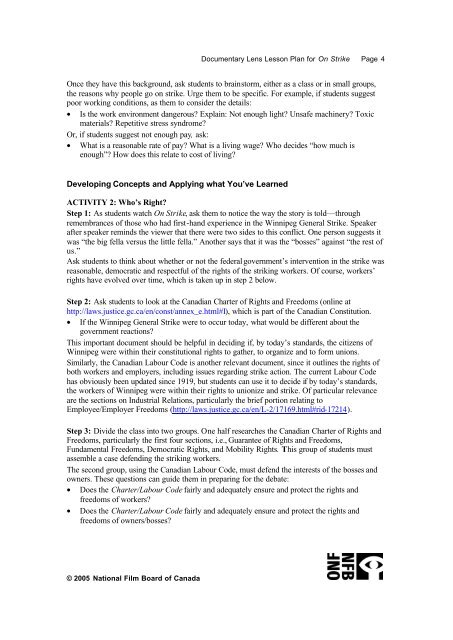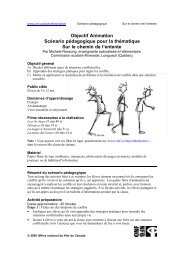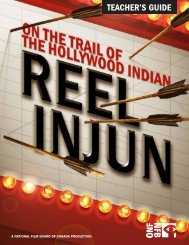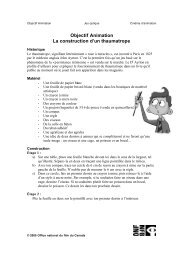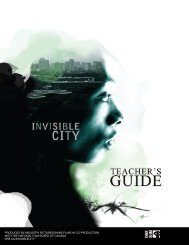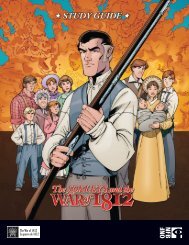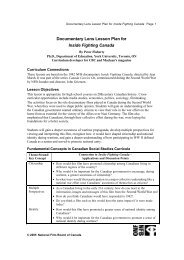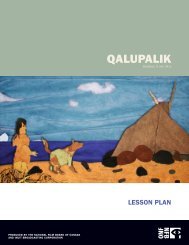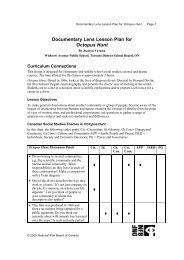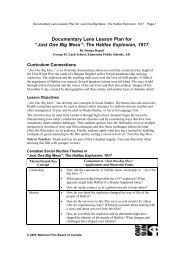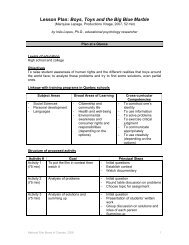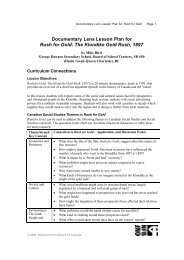Documentary Lens Lesson Plan for On Strike - Office national du film ...
Documentary Lens Lesson Plan for On Strike - Office national du film ...
Documentary Lens Lesson Plan for On Strike - Office national du film ...
Create successful ePaper yourself
Turn your PDF publications into a flip-book with our unique Google optimized e-Paper software.
<strong>Documentary</strong> <strong>Lens</strong> <strong>Lesson</strong> <strong>Plan</strong> <strong>for</strong> <strong>On</strong> <strong>Strike</strong> Page 4<strong>On</strong>ce they have this background, ask students to brainstorm, either as a class or in small groups,the reasons why people go on strike. Urge them to be specific. For example, if students suggestpoor working conditions, as them to consider the details:• Is the work environment dangerous? Explain: Not enough light? Unsafe machinery? Toxicmaterials? Repetitive stress syndrome?Or, if students suggest not enough pay, ask:• What is a reasonable rate of pay? What is a living wage? Who decides “how much isenough”? How does this relate to cost of living?Developing Concepts and Applying what You’ve LearnedACTIVITY 2: Who’s Right?Step 1: As students watch <strong>On</strong> <strong>Strike</strong>, ask them to notice the way the story is told—throughremembrances of those who had first-hand experience in the Winnipeg General <strong>Strike</strong>. Speakerafter speaker reminds the viewer that there were two sides to this conflict. <strong>On</strong>e person suggests itwas “the big fella versus the little fella.” Another says that it was the “bosses” against “the rest ofus.”Ask students to think about whether or not the federal government’s intervention in the strike wasreasonable, democratic and respectful of the rights of the striking workers. Of course, workers’rights have evolved over time, which is taken up in step 2 below.Step 2: Ask students to look at the Canadian Charter of Rights and Freedoms (online athttp://laws.justice.gc.ca/en/const/annex_e.html#I), which is part of the Canadian Constitution.• If the Winnipeg General <strong>Strike</strong> were to occur today, what would be different about thegovernment reactions?This important document should be helpful in deciding if, by today’s standards, the citizens ofWinnipeg were within their constitutional rights to gather, to organize and to <strong>for</strong>m unions.Similarly, the Canadian Labour Code is another relevant document, since it outlines the rights ofboth workers and employers, including issues regarding strike action. The current Labour Codehas obviously been updated since 1919, but students can use it to decide if by today’s standards,the workers of Winnipeg were within their rights to unionize and strike. Of particular relevanceare the sections on In<strong>du</strong>strial Relations, particularly the brief portion relating toEmployee/Employer Freedoms (http://laws.justice.gc.ca/en/L-2/17169.html#rid-17214).Step 3: Divide the class into two groups. <strong>On</strong>e half researches the Canadian Charter of Rights andFreedoms, particularly the first four sections, i.e., Guarantee of Rights and Freedoms,Fundamental Freedoms, Democratic Rights, and Mobility Rights. This group of students mustassemble a case defending the striking workers.The second group, using the Canadian Labour Code, must defend the interests of the bosses andowners. These questions can guide them in preparing <strong>for</strong> the debate:• Does the Charter/Labour Code fairly and adequately ensure and protect the rights andfreedoms of workers?• Does the Charter/Labour Code fairly and adequately ensure and protect the rights andfreedoms of owners/bosses?© 2005 National Film Board of Canada


